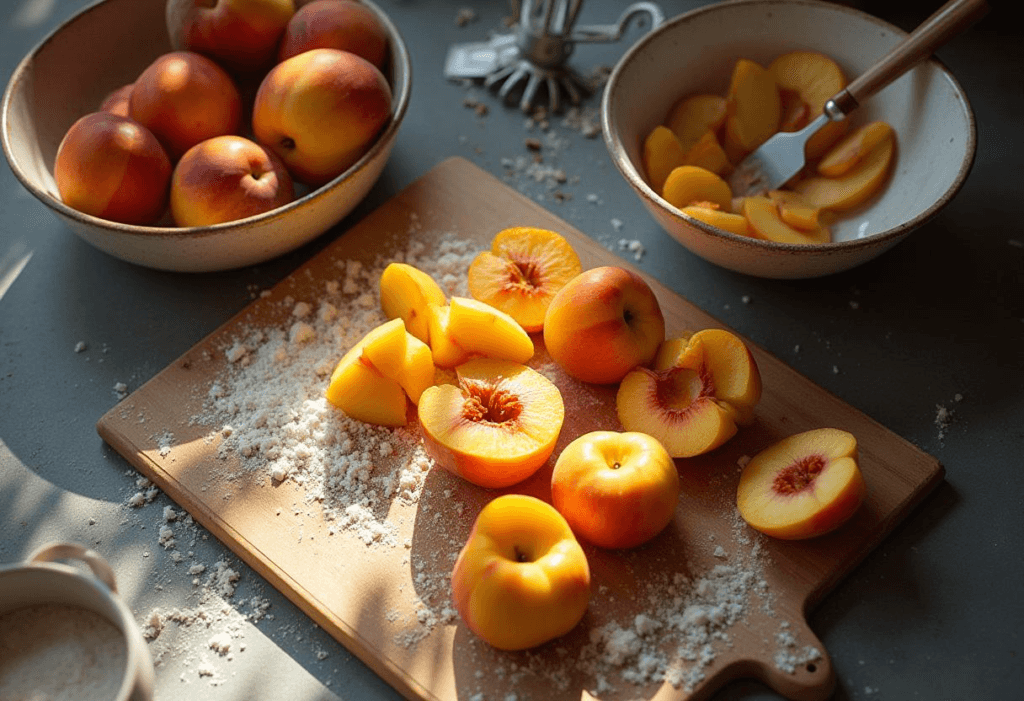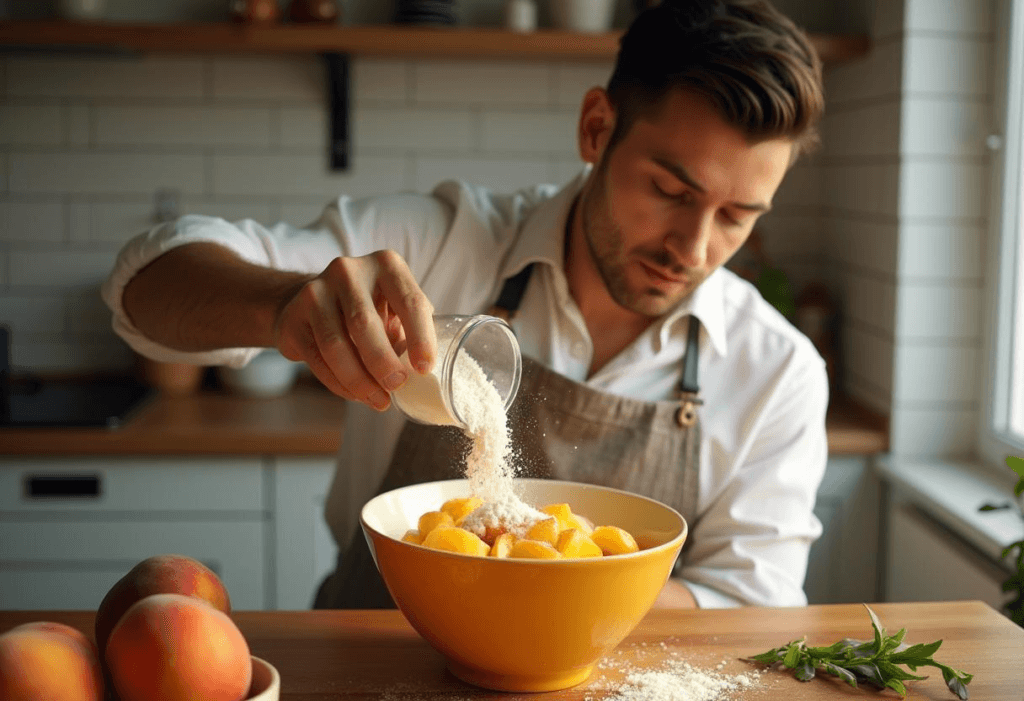Few things are more disappointing than cutting into a warm, freshly baked peach cobbler—only to find it runny instead of thick and delicious. If you’ve ever wondered how to keep peach cobbler from being runny, you’re not alone!.
If you’ve ever wondered how to keep peach cobbler from being runny, you’re not alone!
Peaches naturally release a lot of juice while baking, and without the right techniques, your cobbler can turn into a peach-flavored puddle instead of a perfectly gooey, thick dessert.
So, how do you make sure your peach cobbler turns out perfectly thick? The secret lies in using the right peaches, the best thickening agents, and proper baking techniques.
So, how do you keep peach cobbler from being runny? The answer lies in choosing the right peaches, using the correct thickening agents, and following key baking techniques.
In this guide, you’ll learn:
Why peach cobbler gets watery and how to prevent it.
The best ingredients and methods for thickening the filling.
Step-by-step baking tips to get a gooey (not soupy) cobbler.
Troubleshooting tips if your cobbler is already runny.
By the end of this article, you’ll have all the secrets to making a thick, jammy, and absolutely delicious peach cobbler every time!
Best Thickening Agents: How to Keep Peach Cobbler from Being Runny
Peaches are the star ingredient, so choosing the right ones can make or break your cobbler’s texture.
Choosing the Right Type of Peaches
Not all peaches are created equal when it comes to baking! Some are firmer and hold their shape, while others break down too much, creating excess liquid.
For more tips on making the perfect fruit-based dessert, check out these 5 secrets for the best peach crumble recipe.
| Peach Type | Best for Cobbler? | Why? |
|---|---|---|
| Freestone Peaches | Yes | Firm, sweet, and easy to slice. |
| Clingstone Peaches | No | Too soft; release excess liquid. |
| White Peaches | No | More delicate and watery. |
| Yellow Peaches | Yes | Balanced flavor with ideal texture. |
« For the best cobbler, use fresh, ripe, yet firm freestone or yellow peaches—they hold their texture and won’t flood your dish! »

Fresh vs. Frozen vs. Canned Peaches: Which One Works Best?
If fresh peaches aren’t available, you might be tempted to use frozen or canned peaches—but be careful! They contain more water, which can ruin the consistency of your cobbler.
What’s the best choice?
Fresh Peaches – Best option, releases the least excess liquid.
Frozen Peaches – Can work, but must be thawed and drained first.
Canned Peaches – Least ideal, contain added syrup and moisture.
💡 Pro Tip: If using frozen or canned peaches, drain them well and toss them in a bit of cornstarch before baking to help absorb excess juice.
How to Keep Peach Cobbler from Being Runny with Proper Thickeners
A runny cobbler is usually the result of not using the right thickening agent. Peaches naturally contain a lot of water, and as they bake, they release juices—so you need something to trap that liquid and turn it into a rich, jammy filling.
Using Cornstarch: The #1 Thickening Agent
Cornstarch is the best and most reliable way to thicken peach cobbler. It binds with the peach juices and turns them into a luscious, thick syrup.
Use 1 to 2 tablespoons of cornstarch per 4 cups of peaches.
Mix cornstarch with sugar before adding to the peaches—this prevents clumping.
Bake at 375°F (190°C) to ensure the cornstarch activates properly.
« Cornstarch is the secret ingredient that transforms peach juice into a perfectly gooey, not watery, filling! »

Alternatives to Cornstarch: Flour, Tapioca, or Arrowroot?
If you don’t have cornstarch, there are other options:
| Thickener | How Much to Use? | Pros & Cons |
|---|---|---|
| Flour | 2 tbsp per 4 cups of peaches | Works, but makes the filling cloudy. |
| Tapioca Starch | 1 tbsp per 4 cups | Creates a glossy, smooth filling. |
| Arrowroot Powder | 1 tbsp per 4 cups | Good alternative, but can be slimy. |
💡 Pro Tip: For a perfectly clear, thick cobbler filling, use cornstarch or quick-cooking tapioca.
Baking Hacks: How to Keep Peach Cobbler from Being Runny Every Time
Should You Pre-Cook the Peach Filling? Pros & Cons
Pre-cooking the peach filling helps remove excess liquid and activate the thickener before baking.
Pros: Helps control moisture, prevents runny filling.
Cons: Slightly more work, can make peaches too soft.
How to do it:
- Toss sliced peaches with sugar, cornstarch, and lemon juice.
- Simmer on medium heat for 5 minutes, until juices start to thicken.
- Let it cool before adding the topping and baking.
Mastering the perfect crumbly topping is key—find out the secret to a good crumble here!
« Pre-cooking the filling gives you total control over consistency—it’s the best method if you struggle with watery cobblers! »
The Draining Method: How to Remove Excess Peach Juice
If pre-cooking feels like too much effort, another trick is draining the peaches before baking.
Sprinkle sliced peaches with sugar and let them sit for 15-20 minutes.
Drain the excess juice before adding cornstarch and baking.
Pro Tip: Draining works best if you’re using canned or frozen peaches, which hold extra moisture.
Getting the Cobbler Topping Just Right
The topping plays a bigger role than you might think in keeping your peach cobbler from getting runny. A poorly balanced topping can trap moisture underneath, making the filling watery instead of thick and gooey.
Why the Topping Affects Cobbler Consistency
A proper cobbler topping should be light, crisp, and golden brown, allowing steam to escape. But how to keep peach cobbler from being runny when using a thick crust? The key is to bake the filling first before adding the topping, ensuring that excess moisture evaporates before it’s sealed under the crust.
Topping too thick → Traps too much moisture, making the filling soupy.
Undercooked topping → Peaches continue to release liquid while baking.
Too much sugar in topping → Creates extra syrup, making the cobbler too juicy.
« A well-baked topping allows steam to escape, keeping your cobbler thick and jammy! »
Should You Bake the Filling First Before Adding Topping?
Pre-baking the filling is a game-changer if you struggle with runny cobblers.
Baking the peaches for 10 minutes before adding the topping helps evaporate extra moisture.
The cornstarch thickens properly, creating a stable base.
The topping stays crisp, not soggy.
How to do it:
- Bake just the peach filling at 375°F (190°C) for 10-15 minutes.
- Add the cobbler topping and finish baking until golden brown.
Pro Tip: Pre-baking the filling works best for deep-dish cobblers where excess juice is common.
The Right Topping-to-Filling Ratio for a Balanced Cobbler
Using too much topping can prevent the filling from cooking and thickening properly.
| Pan Size | Peaches Needed | Topping Amount |
|---|---|---|
| 8-inch dish | 4 cups sliced peaches | 1 cup topping |
| 9×13-inch dish | 8 cups sliced peaches | 2 cups topping |
« A thinner layer of topping ensures even baking and a thick, gooey filling! »
How to Bake Peach Cobbler Without It Being Runny
Your baking technique also plays a big role in getting the right consistency.
The Best Oven Temperature & Bake Time
Peach cobbler needs the right amount of heat to thicken the juices properly.
Bake at 375°F (190°C) for 35-45 minutes.
If using frozen peaches, bake for 5-10 minutes longer to allow extra moisture to evaporate.
Look for bubbling juices around the edges—this means the thickener is fully activated.
Pro Tip: If the topping browns too fast, cover it loosely with foil to allow the filling to cook fully.
Why Resting Time Matters Before Serving
Many people rush to serve cobbler right out of the oven, but letting it rest is essential for getting the perfect texture.
Let cobbler cool for at least 20-30 minutes before serving.
This allows the thickener (cornstarch, flour, or tapioca) to set up properly.
The cobbler will thicken as it cools, preventing a soupy mess.
« Cobbler fresh from the oven might look runny—but give it time, and it will thicken beautifully! »
How to Tell If Your Cobbler Is Fully Baked
Not sure if your cobbler is done? Here’s how to check:
Golden brown topping – Crispy, lightly browned crust.
Juices bubbling around edges – This means the filling is fully cooked.
Thickened consistency – Tilt the dish slightly—if liquid pools in the corner, bake for another 5 minutes.
« A properly baked cobbler should have bubbling, thickened juices and a crisp, golden topping! »
How to Fix a Runny Peach Cobbler After Baking
What if you’ve already baked your cobbler and it’s still too runny? Don’t panic! Here’s how to fix it.
Can You Fix a Runny Cobbler After Baking?
How to keep peach cobbler from being runny? If your cobbler is too watery, there are a few ways to fix it.
Bake it longer – If the juices are still thin, return it to the oven for 5-10 more minutes.
Let it cool completely – Many cobblers thicken as they cool.
Sprinkle in extra thickener – Mix a teaspoon of cornstarch with a little warm water and stir into the cobbler before baking a bit longer.
« Sometimes all your cobbler needs is a little extra baking time to thicken up properly! »
How to Save a Watery Cobbler with a Quick Fix
If your cobbler is already baked and still too runny, you can salvage it with these methods:
Drain some liquid: Carefully tilt the dish and spoon out excess juice.
Add a crumble topping: Sprinkle extra crumbly topping over the cobbler and bake for another 5-10 minutes.
Serve with ice cream! A slightly runny cobbler pairs well with vanilla ice cream, making it a delicious syrupy treat.
« A little extra juice isn’t the end of the world—just turn it into a peach cobbler sundae! »
Best Ways to Store & Reheat Cobbler Without Losing Texture
Proper storage can prevent cobbler from becoming too watery after a day or two.
Storing Leftover Cobbler
Refrigerate leftovers in an airtight container for up to 4 days.
For longer storage, freeze peach cobbler (without the topping) for up to 3 months.
Reheating Tips to Keep It Thick & Crispy
The wrong reheating method can make cobbler soggy—here’s how to do it right:
Oven: Reheat at 350°F (175°C) for 10-15 minutes to restore crispiness.
Air Fryer: 5-7 minutes at 325°F (160°C) works well for a small portion.
Microwave (not recommended) – Can make the cobbler mushy.
« For the crispiest results, always reheat cobbler in the oven! »
FAQs
Why Is My Cobbler Still Watery Even with Cornstarch?
The cobbler may need more baking time to fully activate the thickener.
Make sure to mix cornstarch with sugar first to prevent clumping.
Can I Use Frozen Peaches Without Making Cobbler Runny?
Yes, but thaw and drain them first, then toss them in cornstarch or flour before baking.
How Long Should I Let Cobbler Cool Before Serving?
At least 20-30 minutes! This allows the filling to set properly and prevents excess liquid from pooling.
Conclusion
So, how to keep peach cobbler from being runny? The answer is all about choosing the right peaches, using a proper thickener, and baking at the correct temperature. Follow these expert tips, and you’ll never have to deal with a watery cobbler again!
Use fresh, firm peaches (not too ripe or canned).
Thic ken the filling with cornstarch or tapioca.
Pre-bake the peaches or drain excess liquid.
Bake at 375°F (190°C) until juices bubble and thicken.
Let cobbler rest before serving—cooling time matters!
Now that you know how to keep peach cobbler from being runny, you can enjoy a thick, gooey, and perfectly baked dessert every time! »

